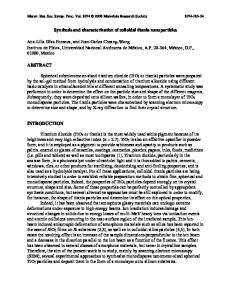Synthesis and Characterization of Novel Inverted NiO@Ni x Mn 1-x O Core-Shell Nanoparticles
- PDF / 887,556 Bytes
- 6 Pages / 612 x 792 pts (letter) Page_size
- 36 Downloads / 487 Views
Synthesis and Characterization of Novel Inverted NiO@NixMn1-xO Core-Shell Nanoparticles Samiul Hasan1, R.A. Mayanovic1, Mourad Benamara2 1 Department of Physics, Astronomy and Materials Science, Missouri State University, Springfield, MO 65897, USA. 2 Institute for Nano Science & Engineering, University of Arkansas, Fayetteville, AR, USA ABSTRACT Magnetic core-shell nanoparticles have the potential for numerous applications, such as in magnetic recording media, magnetic resonance imaging, drug delivery or hyperthermia, and spin valves. Inverse core-shell nanoparticles, comprised of an antiferromagnetic (AFM) core covered by a ferromagnetic (FM) or ferrimagnetic (FiM) shell, are of current interest due to the tunability of their magnetic properties. NiO is typically antiferromagnetic in nature and has a Néel temperature of 523 K. Our primary objective in this project is to synthesize and characterize inverted core-shell nanoparticles (CSNs) comprised of a NiO (AFM) core and a shell consisting of a NixMn1-xO (FM/FiM) compound. The synthesis of the CSNs was made using a two-step process. The NiO nanoparticles were synthesized using a chemical reaction method. Subsequently, the NiO nanoparticles were used to grow the NiO@NixMn1-xO CSNs using our hydrothermal nano-phase epitaxy method. XRD structural characterization shows that the NiO@NixMn1-xO CSNs have the rock salt cubic crystal structure throughout. SEM-EDS data indicates the presence of Mn in the CSNs. SQUID magnetic measurements show that the CSNs exhibit AFM/FM or AFM/FiM characteristics with a coercivity field of 425 Oe at 5 K. The field cooled vs zero field cooled hysteresis loop measurements show a significant exchange bias effect between the AFM NiO core and FM/FiM NixMn1-xO shell of the CSNs. The results of additional TEM and magnetic characterization are discussed. INTRODUCTION Core-shell nanoparticles (CSNs) have attracted considerable attention due to their potential applications in a number of industrially important areas. The properties of CSNs can be controlled by tuning their core size, shell thickness, composition, surface functionality and other parameters. CSNs have many potential applications in catalysis, materials chemistry, sensors, magnetic random access memory, spintronic devices and biomedical application [1,2]. The physicochemical properties of nanoscale metal oxides depend on particle size, shape, surface area and homogeneity, which in turn depend on the synthesis methods that were used for their preparation. For the synthesis of core-shell nanoparticles, different methods such as homogenous precipitation, co-precipitation, impregnation, sol-gel, sono-chemical, micro-emulsion, hydrothermal, and thermal decomposition methods have been used [3]. The most common research interest area for bi-magnetic core-shell nanoparticles is in controlling the magnetic properties of the core vs the shell. Typically, this is enabled by synthesizing a core having ferromagnetic/ferrimagnetic (FM/FiM) properties whereas the shell has antiferromagnetic
Downloa
Data Loading...











